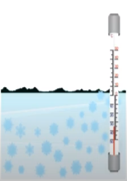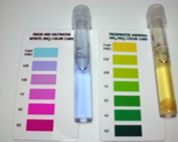Water Quality Basics
Properties
Properties of water
The fluctuation of Optimum level of those 3 types of properties of water into desired level affects the water quality.
Water quality testing is an important part of environmental monitoring. When water quality is poor, it affects not only aquatic life but the surrounding ecosystem as well.
| Biological | Physical | Chemical | |
|---|---|---|---|
| Cohesion | Temperature | pH | |
| Adhesion | Colour | Alkalinity | |
| Surface tension | Turbidity | Total Hardness | |
| Insulation of Bodies of water |
Insulation of Bodies of water | Taste and Odor | Metals |
| Solvent of Life | Specific Conductivity | Nitrate / Nitrite | |
| Melting Point | DO | ||
| Boiling Point | BOD | ||
| Maximum Density | COD | ||
| TDS |
Physical water quality measurements
A. Temperature Test

- Domestic Supply water temperature is 100 to 150 C or measure by Ordinary thermometer
- Other determining density, viscosity, vapor pressure, surface tension of the water its measure
B. Colour Test

- The maximum permissible color is 10 to 20PPM
PPM = pert per millions or 1PPM = 1mg/liter - Its Measure by platinum cabalt scale
D. Taste and Odour Test

- This may be result microorganism either dead or alive, desolved gasses such as oxygen, carbon mono oxide, methane etc.
- Mineral such as sodium chloride, iron compound, etc.
- Odour test measure by 200C to 250C and apparatus use is known as Osmoscope
- Osmoscope PO value from 0 to 5
| Sample Volume Diluted to 200mL | Threshold Odor Number (TON) | Sample Volume Diluted to 200mL | Threshold Odor Number (TON) |
|---|---|---|---|
| 200 | 1 | 83 | 24 |
| 100 | 2 | 57 | 35 |
| 70 | 3 | 4 | 50 |
| 50 | 4 | 28 | 70 |
| 35 | 6 | 2 | 100 |
| 25 | 8 | 14 | 140 |
| 17 | 12 | 1 | 200 |
Chemical water quality measurements
Biological water quality measurements
The fluctuation of Optimum level of those 3 types of properties of water into desired level affects the water quality.
Water Sampling Methods
Water sampling can be done differently in the different water resources.